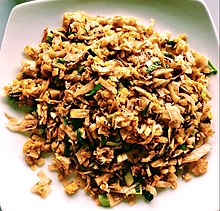food.wikisort.org - Dish
Kottu roti (Tamil: கொத்து ரொட்டி; Sinhala: කොත්තු රොටි),[1][2][3][4] alternatively spelled kothu roti, is a Sri Lankan dish consisting of chopped roti, a meat curry dish of choice (such as mutton, beef, seafood, or chicken), along with scrambled egg, onions, and chillies.[5][3][6][7] The ingredients are chopped together using special cleavers as they sautee on a hot griddle. A variation of the dish is found in the South Indian states of Tamil Nadu and Kerala, known as kothu parotta (Tamil: கொத்து பரோட்டா), which is made using parotta instead of roti. Kottu roti can also be found internationally in restaurants in regions containing Tamil, Sinhalese and Malayali diaspora populations.[8][9][10][11][12]
 Chicken kottu roti | |
| Alternative names | Kothu roti, kothu parotta, kottu |
|---|---|
| Course | Main course |
| Place of origin | Sri Lanka |
| Serving temperature | Hot |
| Main ingredients | Roti, egg, onion, chilli pepper |
History

The word koththu means "to chop" in Tamil, referring to its method of preparation.[13] This has been simplified in Tamil and Sinhalese to Kothu or Kottu respectively. It is generally considered that it originated as street food in the eastern Tamil regions of Trincomalee or Batticaloa in the 1960s/1970s, as an inexpensive meal for the lower socio-economic classes. The basic rotti is made of Gothamba flour, a flour made out of a variety of grains-referring to the white flour.[14][15]
Another origin theory claims that the dish was created as kothu parotta in Madurai, India,[16][17] where it is made using parotta from Maida, which is called bleached flour in areas outside South Asia.
Preparation
Kottu,[18] is made up of paratha or godamba roti, which is cut into small pieces or ribbons.[18] Then on a heated iron sheet or griddle, vegetables and onions are fried. Eggs, cooked meat, or fish are added to fried vegetables and heated for a few minutes. Finally, the pieces of cut paratha are added. These are chopped and mixed by repeated pounding using heavy iron blades/spatula, the sound of which is very distinctive and can usually be heard from a long distance. Depending upon what ingredients are used, the variations are vegetable, egg, chicken, beef, mutton, and fish kottu roti.[19] It is sometimes prepared and served as a fast food dish.[19]
See also
- Cuisine of Sri Lanka
References
- Senaratne, Chamindi Dilkushi. Sinhala-English Code-mixing in Sri Lanka: A Sociolinguistic Study. Vol. 217. Utrecht: Landelijke Onderzoekschool Taalwetenschap. p. 299. ISBN 9789078328926.
- Lopamudra Maitra Bajpai (2020). India, Sri Lanka and the SAARC Region: History, Popular Culture and Heritage. Taylor & Francis. p. 254. ISBN 9781000205817.
- Kraig, Bruce Kraig; Taylor, Colleen (2013). Street Food around the World: An Encyclopedia of Food and Culture. ABC-CLIO. p. 328. ISBN 9781598849554.
- Thaker, Aruna; Barton, Arlene, eds. (2012). Multicultural Handbook of Food, Nutrition and Dietetics. John Wiley & Sons. p. 88. ISBN 9781118350461.
- Reeves, Peter, ed. (2013). The Encyclopedia of the Sri Lankan Diaspora. Editions Didier Millet. p. 174. ISBN 9789814260831.
- "Chicken Kottu Roti Recipe". New York Times. Retrieved 12 September 2015.
- "Patak's Beef Kottu Rotti Recipe". Daily Telegraph. 8 February 2014. Retrieved 12 September 2015.
- "Spice City Toronto: Sri Lanka comes to Queen Street". torontoist.com. 8 November 2013. Retrieved 12 September 2015.
- Bartholomeusz, Rachel (2 June 2017). "Where to eat in Sydney's Little Sri Lanka". Good Food Guide - Australia. Retrieved 3 November 2022.
- Ueda, Reed, ed. (2017). America's Changing Neighborhoods: An Exploration of Diversity through Places. ABC-CLIO. p. 1064. ISBN 9781440828652.
- "SL Embassy in US woos tourists during winter season". Daily News. 10 October 2022. Retrieved 3 November 2022.
- Goldfield, Hannah (22 July 2022). "An Astonishing Array of Sri Lankan Specialties, at Queens Lanka". The New Yorker. Retrieved 3 November 2022.
- Lam, Francis (26 November 2014). "Sri Lankan Kottu Roti, by Way of Staten Island". nytimes.com. Retrieved 25 April 2020.
- Kannangara, Yashasvi (21 August 2011). "Roti hunt". Sunday Times. Retrieved 3 November 2022.
- "Ultimate Guide to making Roti at home". SBS Television. 2 November 2021. Retrieved 3 November 2022.
- "Kothu Parotta is The Most Delicious Street Food Item to Try in Tamil Nadu". NDTV Food.
- "Watch: Here is how the iconic Madurai Arumugam Mess 'kothu parotta' is made". 5 December 2018 – via www.thehindu.com.
- Taylor, G. (2017). MasterChef: Street Food of the World. Bloomsbury Publishing. p. 214. ISBN 978-1-4729-4620-1. Retrieved 9 February 2018.
- Briggs, P. (2018). Sri Lanka. Bradt Travel Guide. Sri Lanka. Bradt Travel Guides. p. 54. ISBN 978-1-78477-057-0. Retrieved 9 February 2018.
External links
![]() Media related to Kottu at Wikimedia Commons
Media related to Kottu at Wikimedia Commons
Другой контент может иметь иную лицензию. Перед использованием материалов сайта WikiSort.org внимательно изучите правила лицензирования конкретных элементов наполнения сайта.
WikiSort.org - проект по пересортировке и дополнению контента Википедии